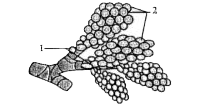Name the structure/organs in plants that are used for gaseous exchange
Step-by-Step Solution:
1. Identify the Main Structure for Gaseous Exchange:
- The primary structure in plants responsible for gaseous exchange is the leaf.
2. Understand the Role of Stomata:
- Within the leaf, there are numerous small openings called stomata. These stomata facilitate the exchange of gases (such as oxygen and carbon dioxide) between the plant and the atmosphere.
3. Recognize the Function of Stomata:
- Stomata are crucial because they allow for the intake of carbon dioxide, which is necessary for photosynthesis, and the release of oxygen, a byproduct of this process.
4. Mention Other Structures:
- While leaves and stomata are the main organs for gaseous exchange, it's important to note that some gaseous exchange can also occur through other parts of the plant, such as stems. However, the contribution from these parts is minimal compared to leaves.
5. Clarify the Role of Roots:
- Although roots are not primarily involved in gaseous exchange, they play a significant role in the uptake of water and minerals from the soil. This is important for the overall health of the plant, but it does not directly relate to gas exchange.
Final Answer:
The main structures in plants used for gaseous exchange are the leaves, specifically through the stomata present on them.
---
- The primary structure in plants responsible for gaseous exchange is the leaf.
- Within the leaf, there are numerous small openings called stomata. These stomata facilitate the exchange of gases (such as oxygen and carbon dioxide) between the plant and the atmosphere.
- Stomata are crucial because they allow for the intake of carbon dioxide, which is necessary for photosynthesis, and the release of oxygen, a byproduct of this process.
- While leaves and stomata are the main organs for gaseous exchange, it's important to note that some gaseous exchange can also occur through other parts of the plant, such as stems. However, the contribution from these parts is minimal compared to leaves.
- Although roots are not primarily involved in gaseous exchange, they play a significant role in the uptake of water and minerals from the soil. This is important for the overall health of the plant, but it does not directly relate to gas exchange.
The main structures in plants used for gaseous exchange are the leaves, specifically through the stomata present on them.
Topper's Solved these Questions
- BOOK - AAKASH INSTITUTE ENGLISHCHAPTER - RESPIRATION IN PLANTS EXERCISE - Try Yourself12videos
RESPIRATION IN PLANTS
- BOOK - AAKASH INSTITUTE ENGLISHCHAPTER - RESPIRATION IN PLANTS EXERCISE - Exercise20videos
RESPIRATION IN PLANTS
- BOOK - AAKASH INSTITUTE ENGLISHCHAPTER - REPRODUCTIVE HEALTH EXERCISE - Sectoin -D Assertion - Reason Type Questions22videos
REPRODUCTIVE HEALTH
- BOOK - AAKASH INSTITUTE ENGLISHCHAPTER - SEXUAL REPRODUCTION IN FLOWERING PLANTS EXERCISE - Assignment (SECTION D)20videos
SEXUAL REPRODUCTION IN FLOWERING PLANTS
Similar Questions
Knowledge Check
- Question 1 - Select One
In a plant organ which is convered by periderm and in which the stomata are absent, some gaseous exchange still takes place through
AlenticelsBtrichomesCaerenchymaDpneumatophores
Study the diagram given below and answer the questions that follow:

Name the structure which is involved in gaseous exchange inside the lungs.View SolutionAerating pores found on woody stems for gaseous exchange
View SolutionWhat is the site of gaseous exchange in an insect?
View SolutionWhat is the site of gaseous exchange in an insect?
View SolutionName two structures found in plant cell but not in animal cell.
View SolutionA : Stomata have delegated the task of providing food while preventing thirst .
R : They are made for gaseous exchange .View SolutionName the state of matter that changes to gaseous state on heating.
View Solution

